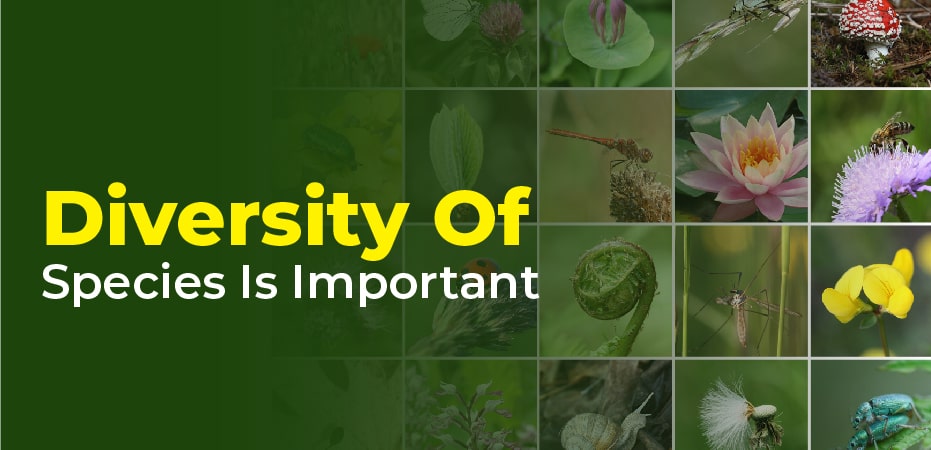The diversity of species in a given community is defined as the number of species within it. To obtain the same mean proportional species abundance as observed in the data set of interest, the effective number of species must be the same as that observed in it.
In an area with an equal abundance of all species, biodiversity is greatest. There are two components to it:
- The richness of species in an ecosystem is defined as the number of species present. Tropical areas have higher species richness since their ecosystems are suited to a large number of species
- Evenness of species: The relative abundance of individuals of each species. The evenness of a species is measured by its number of individuals varying between species, whereas the evenness of species is measured by the number of individuals across all species in the species. The more even the species, the more diversity it exhibits.
There can be high species richness in an ecosystem, but low species equalization.
Here are some examples:
- The species richness of a forest may be high, but the species evenness may be low (due to a small number of each species in the forest).
- During a forest’s growth, there can be only a few varieties of plants, but there could be a large number of each species.
The diversity of species varies with different geographical locations, with tropical biomes having higher diversity and poles having lower diversity. Tropical rainforests, coral reefs, and ocean bottom zones are environments with a great deal of species diversity. As explored area increases, species diversity increases.

Diversity Of Species Is Important
Species diversity and balance are key elements of keeping an ecosystem in balance. In ecosystems, every species is interdependent. Maintaining a high diversity of species is therefore essential to creating a more productive ecosystem.
- Generally, ecosystems with a greater diversity exhibit greater productivity. E.g. biomes with a rich diversity of producers will have high biomass to sustain a broader variety of consumers
- A more diverse and productive ecosystem is more resilient and stable
- A more diverse ecosystem is better able to resist environmental stresses like droughts or invasive species
- as a rich ecosystem is likely to be able to deal with any catastrophe
- When a community contains a lot of different species, they can all use a different portion of the available resources. The shallow soil can provide plants with water, and the deeper soil can provide them with minerals
- . Diversity is essential for humanity’s survival
- In addition to storing and recycling nutrients, protecting soil from erosion, absorbing harmful gases, and stabilizing climate, healthy biodiversity provides numerous benefits.
- Humans get a lot of food from nature, including fruits, cereals, meat, wood, fiber, raisin, dyes, medicines, and antibiotics.
- According to estimates, Amazon forests contribute to 20 percent of the world’s total oxygen supply through photosynthesis
- The pollinators, the symbiotic relationships, the decomposers, each plays an incredibly important role, one that cannot be replaced
- When diversity is large, it contributes to large scale interactions between organisms, such as among organisms that are in the same food web
- An important relationship exists between bacteria, plants, and earthworms in the nitrogen cycle
- Recreation, tourism, education, and research are some of the other benefits.
Species Diversity Examples In Ecosystems With A High Level Of Biodiversity
Tropical Rainforests: Half the species on earth live there. Between five and ten million insect species live there. In the tropical regions grow 40% of all flowering plants. Tropical forests have 30% of the world’s bird species. Tropic forests have a high species diversity largely because climate conditions are relatively constant.
The large coral reef ecosystem is built from thousands of colonies of coral animals. Coral reef systems are known for the clarity of their water, which allows sunlight to penetrate deeply, resulting in algae in the coral producing high levels of photosynthesis. Species diversity is a result of the adaptation of organisms and their niche specializations to various disturbances.
With a surface area of 349,000 square kilometers, the Great Barrier Reef of Australia is the world’s largest coral reef. Corals make up about 400 species, while fish make up 1500 species, mollusks make up 4000 species, and turtles make up six species. Birds breeding here number roughly 250 species. Although it covers just 0.1% of the ocean, it has 8% of all species of fish found worldwide. The unknown species number in the thousands.
Biodiversity Threats
Human activities are largely responsible for the accelerated extinction rate of species. We call these four factors the “Evil Quartet”.
Here are the following:
- Habitat Loss and Fragmentation: Pollution, urbanization, and other human activities are responsible for habitat loss and fragmentation, which are driving species extinctions. E.g.
- Rainforests on Amazon are being cut and cleared in various ways. Rainforests on Amazon are also the home of millions of species
- Today, tropical rainforests cover only 6% of the earth’s landmass, down from 14% once
- Overexploitation of natural resources has led to the extinction of many species.For example, many marine fishes have been overfished, such as the Steller’s sea cow and the passenger pigeon
- Alien species invasions: Whether intentionally introduced or unintentionally, some alien species become invasive and eventually wiped out indigenous species. E.g.
- Nile perch introduced into Lake Victoria results in the extinction of cichlid fish
- African catfish are being introduced illegally into rivers and threaten native catfish populations
- Co-extinctions: Whenever a species goes extinct, the species it is associated with goes extinct as well. E.g.
- In the event of the extinction of the host fish, the parasite is also wiped out
- As is the case with a plant pollinator, when one species goes extinct, the others also go extinct


